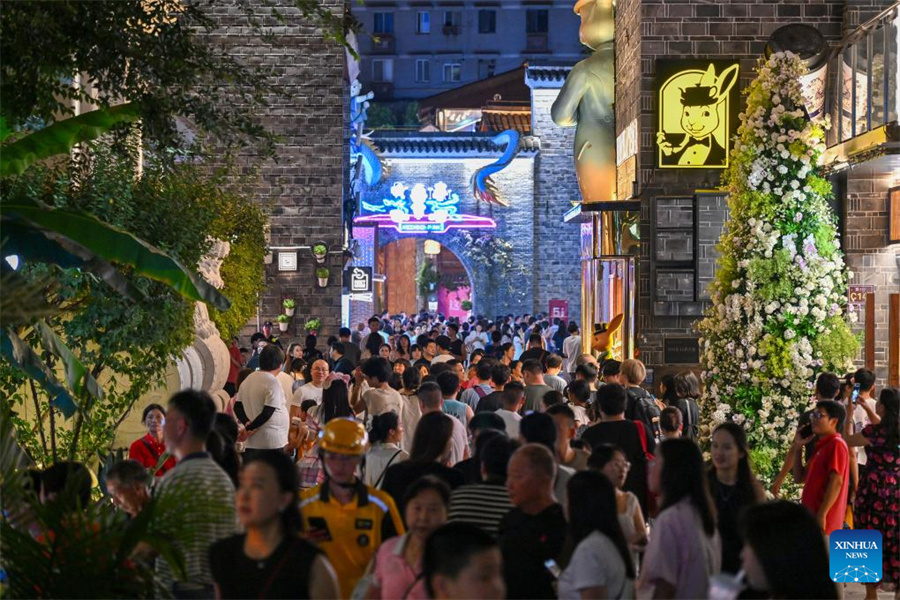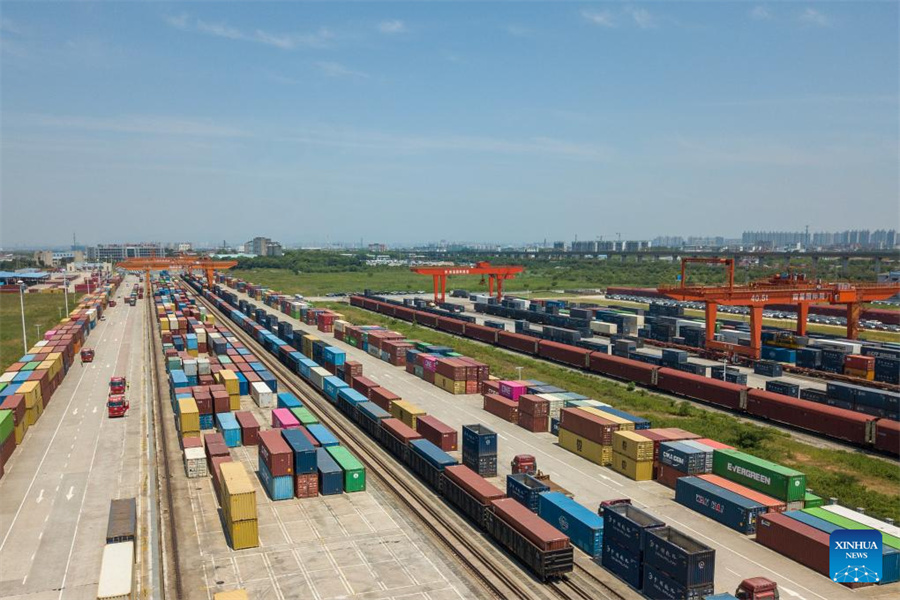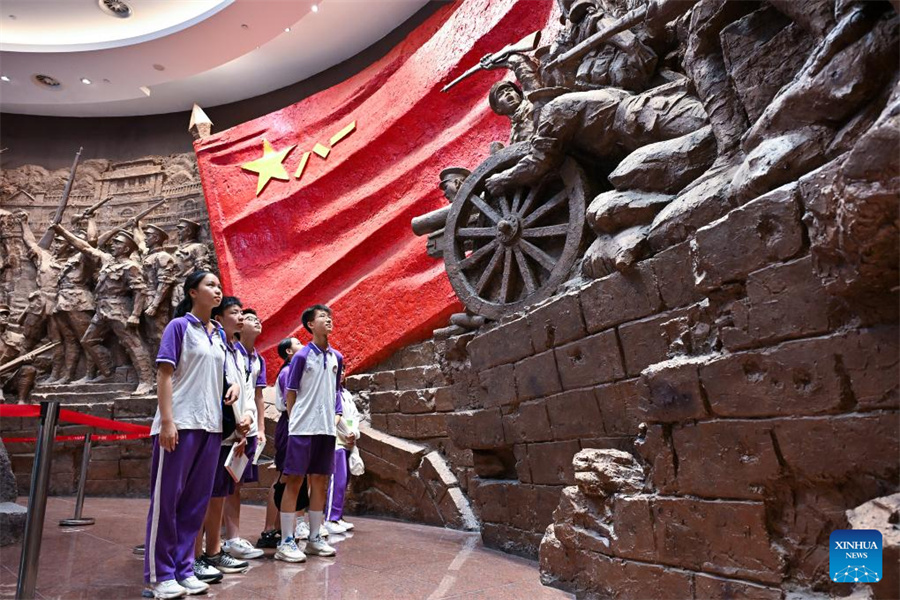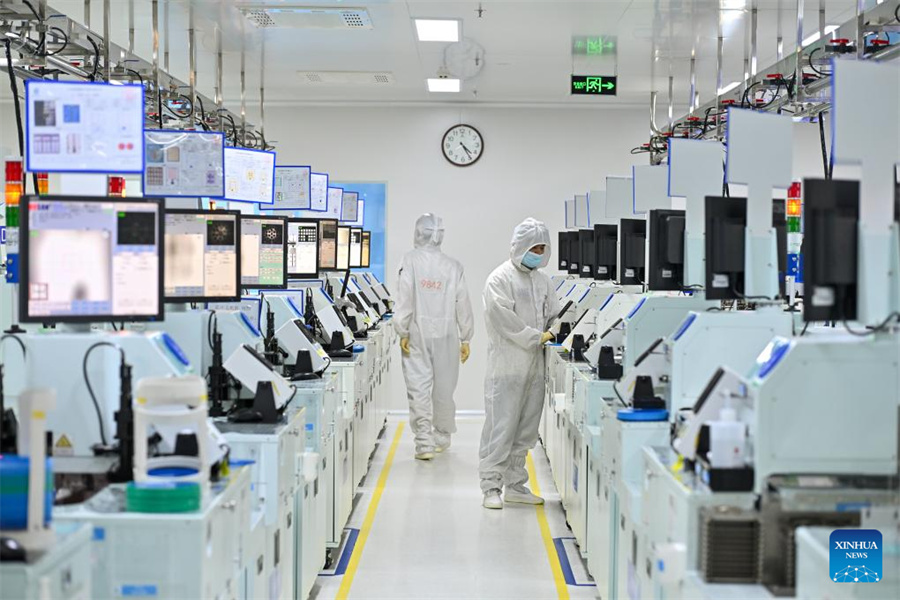Historic east China city thrives by leveraging cultural heritage, global trade

Tourists visit the Wanshou Palace cultural block in Nanchang, east China's Jiangxi Province, July 22, 2024. [Xinhua/Li Xin]
NANCHANG -- Nearly 100 years ago, an uprising in Nanchang, the capital city of east China's Jiangxi Province, marked the birth of the first army under the command of the Communist Party of China, earning Nanchang the title "hero city."
Boasting its old-time glory, Nanchang is undergoing a new era of rejuvenation, emerging as a hub of innovation and land trade. The city's commitment to opening up has breathed new life into its population of over 6.5 million, positioning it as a key player in China's modernization while earnestly preserving its rich historical and cultural heritage.
BREAKTHROUGH IN INNOVATION
Innovation is at the heart of Nanchang's development strategy. The LED industry here exemplifies this innovation-driven economic growth, as the local government fully understands that innovation is crucial for unlocking the city's medium and long-term growth potential.
The high-powered silicon substrate-based LED chips, used for display screens, saw China become the third country after Japan and the United States to secure intellectual property rights for blue LEDs, said Wang Qiong, vice director of the strategic development department of Lattice Power, which produces the LED chips.
Lattice Power's LED products boast luminous efficiency on par with the cutting-edge LEDs developed by Japanese and U.S. firms, while having a pricing advantage due to their use of cheaper materials, Wang said.
This technology won the first prize in China's State Technological Invention Award in 2015.
The Nanchang-based company has developed an industrial cluster to produce LED screens for illumination solutions in areas such as aircraft, automobiles and smartphones, and realized an output value growth of about 40 percent in the first half of this year.
Wang said that Lattice Power invests around 10 percent of its annual revenues in research and development, pursuing a high-quality development path with research and talent as its core focus.
OPENING UP TO WORLD
At the forefront of Nanchang's economic opening up is a major land port for international trade. This ambitious project, covering an area of 33.82 square km, has become a crucial link in the Belt and Road Initiative.
The port's success is evident in its rapid expansion of international trade routes. As of 2024, it has launched 23 international freight train routes, connecting Nanchang with over 50 countries and regions.
On July 20, a significant milestone was achieved as the inaugural "Nanchang-Tashkent" freight train set off from the port. The train carried 938 tonnes of goods worth 26.05 million yuan (about 3.65 million U.S. dollars) to Central Asia.
This new route will not only explore new markets for domestic products but also significantly reduce transportation costs for foreign trade businesses, said Chen Wei, a business manager at the port.
More remarkable developments have been made in Nanchang's logistics sector. On July 11, the province's first sea-rail inter-modal train loaded with imported durian from Thailand arrived at the land port. This breakthrough in the cold chain has opened new possibilities for the import of fresh produce and export of local specialties, further integrating Nanchang into the global trade networks, Chen said.
The city's commitment to modern logistics is also demonstrated by the JD Asia No. 1 project in the port area. This comprehensive logistics park, spanning 400 mu (26.7 hectares), with an investment of 2 billion yuan serves as e-commerce giant JD.com's core logistics node. The facility uses advanced technologies, including an AGV intelligent warehouse system, that has increased work efficiency by 70 percent while reducing labor costs by over 60 percent.
CULTURAL TOURISM
Ahead of China's Army Day, which falls on Aug. 1, a group of eighth-grade students from Nanchang Yuxin School visited the Nanchang Uprising Memorial Hall to learn about the history of the People's Liberation Army.
"After reading the stories of the martyrs, I was deeply moved by their spirit and contribution. They gave me the courage to face the challenges of life head-on," said Xing Renmei, one of the students who hails from Nanchang.
This month, the memorial hall has attracted nearly 10,000 visitors daily, predominantly young people and tourists from other provinces and regions.
As more Chinese tourist attractions seek long-term development by leveraging their cultural and historical resources, Nanchang's future trajectory is thoughtfully aligned with its rich history spanning over 2,200 years.
In the first half of this year, over 32,000 tourists earned free tickets to Tengwang Pavilion in Nanchang by successfully reciting the famous verse "Preface to Tengwang Pavilion" by Tang Dynasty poet Wang Bo. This initiative is part of a new campaign launched by Jiangxi, which allows students worldwide to gain free or discounted access to local tourist attractions by reciting designated poems or classics.
Over 190 million trips were made to Nanchang in 2023, up 16.9 percent year on year, which increased tourism revenues by 41.3 percent to 197.78 billion yuan, according to official data.
The booming local tourism extends beyond impressive numbers; it has garnered praise for its role in preserving history and intangible cultural heritage.

An aerial drone photo shows the Nanchang International Land Port in Nanchang, east China's Jiangxi Province, July 22, 2024. [Xinhua/Li Xin]

Students from Nanchang Yuxin School visit the Nanchang Uprising Memorial Hall in Nanchang, east China's Jiangxi Province, July 23, 2024. [Xinhua/Li Xin]

Staff work at a factory of Lattice Power in Nanchang, east China's Jiangxi Province, July 22, 2024. [Xinhua/Li Xin]
























